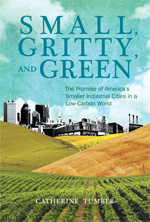
Worcester Sun co-founders Fred Hurlbrink Jr., left, and Mark Henderson.
Previously published at the Nieman Journalism Lab.
Mark Henderson is certainly not the first person to launch a hyperlocal website in the shadow of the daily newspaper that used to employ him. Nevertheless, his ideas about how to build the site into a sustainable business are unorthodox enough to merit attention.
Henderson, a former executive with the 150-year-old Telegram & Gazette of Worcester, Mass., unveiled the Worcester Sun in August. From the start, the Sun’s content has been protected behind a hard paywall of $2 a week. There are no discounts; if you want to subscribe for a year, it will cost you $104.
Once the Sun has attracted a critical mass of paid digital subscribers (Henderson won’t reveal the magic number except to say that it’s well short of 1,000), he’ll add a Sunday paper for $1 a week, perhaps as soon as next spring. Print matters, Henderson says, because that’s still where most of the advertising is.
“If you’re going to start something new, monetizing digital is tough,” says Henderson. “And you can’t look at print as a medium without understanding that there is a ton of money still to be made there. Especially in Sunday print. We could use Sunday print to boost us into the stratosphere, to get us into a stable orbit where we can launch other things.”
Bootstrapping paid digital to break into paid print? Matt DeRienzo, interim executive director of Local Independent Online News (LION) Publishers, says he’s skeptical but intrigued. “Sunday print is going against the grain. There’s a lot of reasons the cards are stacked against them,” says DeRienzo, the former editor of Digital First Media’s Connecticut publications, which include the New Haven Register. But he adds: “The best ideas are going to come from people who live in and care about their community and who are closest to the problem. Who’s to say it’s not going to work?”
With a population of 183,000 — the second-largest city in New England after Boston — and a median household income of about $46,000, more than $20,000 below the state average, Worcester is a city facing economic challenges. It’s precisely the sort of community that could benefit most from independent media projects such as the Sun, says Catherine Tumber, a scholar with the Dukakis Center for Urban and Regional Policy at Northeastern University.
“No one else is coming to their rescue,” says Tumber, the author of the 2011 book “Small, Gritty and Green: The Promise of America’s Smaller Industrial Cities in a Low-Carbon World.” “They have to rely on their own resources and civic ecosystems in order to reconstruct their cities and maintain quality of life there.”
Last week, I met Henderson and his business partner (and cousin) Fred Hurlbrink Jr. in a brightly lit coworking space on the first floor of the Innovation Center of Worcester — formerly the Franklin Street headquarters of the Telegram & Gazette, the daily newspaper where Henderson worked for nearly 25 years. Across the street is City Hall and the Worcester Common. On the other side of the common looms the mid-sized tower that is the current home of the T&G.
Henderson, 49, rose from the paper’s sports department to deputy managing editor for technology and, starting in 2009, online director. He left on June 2, 2014, the day that John Henry, who had purchased The Boston Globe and the T&G from the New York Times Company, sold the T&G to Halifax Media Group of Daytona Beach, Florida, after previously saying he intended to sell to a local group. Halifax cut about 20 journalistsfrom the full-time newsroom staff of about 80. Further cuts came a few months later when Halifax turned around and sold the paper to New Media Investment Group, an affiliate of GateHouse Media, based in the suburbs of Rochester, New York.
Hurlbrink, 38, had two stints with GateHouse — first as a copy editor at The MetroWest Daily News of Framingham and later at the Design House, run out of the Framingham plant, which handled design and some copyediting tasks for multiple GateHouse papers. In August 2014, GateHouse announced that the operation would be closed and moved to Austin, Texas.
Even with a shrunken Telegram & Gazette, Henderson and Hurlbrink find themselves in the midst of a highly competitive media environment. In addition to the T&G, Worcester is covered by MassLive.com, part of Advance Digital; GoLocalWorcester, which has sister sites in Providence, Rhode Island, and Portland, Oregon; and Worcester Magazine, whose parent company, Holden Landmark Corporation, is controlled by GateHouse Media chief executive Kirk Davis but is not part of GateHouse.
In the face of such competition, Henderson and Hurlbrink say their plan is to steer clear of breaking news and offer depth and analysis instead. “We’re never going to cover breaking news,” Henderson says. “Will we cover the opiate epidemic rather than three people who OD’d in the last 24 hours? Yeah, we’ll take a look at that. But we’ll devote the resources to do it and give people an insight that they didn’t have before.”
The Sun’s content so far reflects that philosophy, starting with the August 9 debut, which featured an essay on the city’s bygone newspaper scene by Worcester native Charles P. Pierce, the high-profile journalist and author who these days spends most of his time blogging about politics for Esquire. The Sun has also published stories on the privacy concerns posed by surveillance cameras, the city’s sagging downtown business district, and a mother’s quest to find the educational resources she needs to help her daughter with ADHD. The site also offers such quotidian fare as profiles of local businesses, editorials and, yes, obituaries.
“I think there’s a niche,” says Timothy McGourthy, executive director of the Worcester Regional Research Bureau. “I think it provides kind of a thoughtful human-interest approach to Worcester. It’s a generally positive approach to the city. I think the challenge is going to be getting the word out in the marketplace.”
The Sun’s paywall — as well as that of the T&G — is based on technology provided by Clickshare, whose website touts the software as a “flexible system” that allows for different types of paid access, billing and payment processing, and various options for e-commerce. Bill Densmore, who founded Clickshare in the mid-1990s, believes that print and digital serve two different types of audiences — and that Henderson and Hurlbrink are smart to try to serve both.
“A lean-back experience once a week makes a lot of sense to me,” says Densmore, a research fellow at the Reynolds Journalism Institute. “It’s an experiment, really, and an important one, both for the existing industry and for people starting on the digital side and wondering where that leads. I think the marriage of print and digital makes a lot of sense, particularly if you’re not trying to put out a daily paper, which increasingly seems anachronistic to me and to people in the digital world.”
Starting and maintaining a community news site is a hard way to make a living, but the allure is undeniable. LION counts about 130 member sites, and of course there many more that are not LION members. New ones pop up regularly. Just this week, The Boston Globe reported on a project called The Spark, cofounded by a former photographer for the GateHouse-owned Enterprise of Brockton.
It’s the same allure that has kept Henderson and Hurlbrink going despite setbacks — including a $150,000 Kickstarter campaign that fell well short of the mark. So far, they say, they’ve invested $200,000 in money and time. Soon they hope to unveil the first in a line of ebooks. And they’ve got plans to launch online verticals in areas such as education and local sports. “I think there are places we can go where we can be effective,” says Hurlbrink.
If all goes according to plan, they foresee a staff of 20 full- and part-time journalists. The key, adds Henderson, is to fill a niche — and not worry about what the competition is doing.
“We’ve never said we’re here to take the T&G out,” says Henderson. “Other people have. We don’t agree with that. Our stated goal is to serve our audience, the city of Worcester, the best we can. And if we have an opportunity to grow our audience, all the better.”




 There’s nothing quite listening in on a smart conversation by two old friends. In this week’s Boston Phoenix,
There’s nothing quite listening in on a smart conversation by two old friends. In this week’s Boston Phoenix,